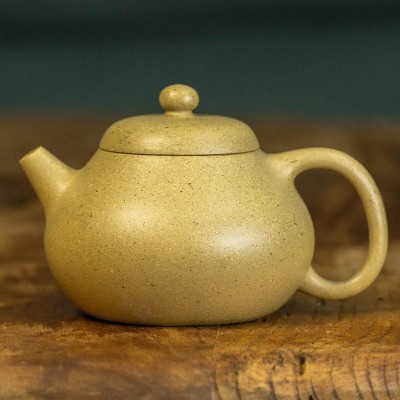





"wendan" in Chinese refers to softness, appearance, and demeanor, while "dan" refers to the female roles in traditional Chinese opera. To literati, the charm and style of the "wendan" teapot are comparable to the beauty of a woman's shoulder, soft and boneless, like the alluring curves of "Xishi", exuding a natural grace and charm. The "wen" in "wendan" represents the soft, delicate appearance of the teapot, while the "dan" represents the feminine qualities that the teapot embodies. The "wendan" teapot is highly valued for its unique and elegant shape, which exudes a natural beauty and grace that is reminiscent of the beauty of a woman.
 Delivery
Delivery
Free shipping within 1 to 3 days. ETA:5-7 days
 Returns
Returns
Within 28 days after delivery date.
 Security
Security
SSL | GDRP used to ensure information security.
Guarantee safe & secure checkout
Data sheet
I love the design of this Yixing Teapot, it's not only beautiful but also very functional. It's perfect for brewing my favorite teas and it's become a staple in my tea collection.
"wendan" in Chinese refers to softness, appearance, and demeanor, while "dan" refers to the female roles in traditional Chinese opera. To literati, the charm and style of the "wendan" teapot are comparable to the beauty of a woman's shoulder, soft and boneless, like the alluring curves of "Xishi", exuding a natural grace and charm. The "wen" in "wendan" represents the soft, delicate appearance of the teapot, while the "dan" represents the feminine qualities that the teapot embodies. The "wendan" teapot is highly valued for its unique and elegant shape, which exudes a natural beauty and grace that is reminiscent of the beauty of a woman.
"wendan" in Chinese refers to softness, appearance, and demeanor, while "dan" refers to the female roles in traditional Chinese opera. To literati, the charm and style of the "wendan" teapot are comparable to the beauty of a woman's shoulder, soft and boneless, like the alluring curves of "Xishi", exuding a natural grace and charm. The "wen" in "wendan" represents the soft, delicate appearance of the teapot, while the "dan" represents the feminine qualities that the teapot embodies. The "wendan" teapot is highly valued for its unique and elegant shape, which exudes a natural beauty and grace that is reminiscent of the beauty of a woman.
"Yangtong" zisha teapot means barrel-shaped pot is a common style among the purple clay teapot varieties, and it is also a special name for a teapot style. Since its creation in the late Qing Dynasty and early Republic of China, the purple clay barrel-shaped pot has become popular due to its simple design, convenient use, easy to handle, and easy to brew tea. It has been widely accepted, appreciated, and collected by most purple clay teapot enthusiasts, and has become one of the classic traditional works of zisha teapot.
The Xishi yixing teapot is the quintessential model and the most popular style of Yixing clay teapot. It boasts a round and plump body, a cut lid, a short spout, and an inverted handle. The pot's body resembles the full breast of a young woman, while the knob on the lid is shaped like a nipple. The bottom of the pot curves inward naturally, and the handle is fashioned like an upside-down ear, reminiscent of the hairstyle of ancient Chinese women. When pouring tea, the handle resembles the slender waist of a beautiful woman. The Xishi teapot is renowned for its unique ability to brew tea, allowing the tea leaves to fully expand and release a more intense aroma and flavor.
"Hanwa" Yixing teapot is shaped like a cylindrical jar, which appears straight up and down, but has an arched middle that gives it a strong tension. The lid is a large, slightly bulging and curved circle, with a bridge-shaped knob on top that slopes gently. The straight spout is of moderate length, while the ear-shaped handle is slightly flattened in the middle. Both the spout and handle are polygonal, providing visual changes and a classic combination of square and round in art.
The "Longdan" Yixing teapot, also known as the Dragon Ball Teapot, has an oval shape with a flat bottom and a smaller top, resembling an egg. It is crafted using traditional handmade techniques, with intricate carvings and fine texture that result in a deep and rich color. This teapot has excellent heat preservation and enhances the aftertaste of tea, making it suitable for brewing various types of tea. It is both elegant and practical, making it a highly sought-after Zisha teapot.
The "Persimmon" is a type of teapot that was created by many teapot makers during the late Qing Dynasty and early Republic of China period. It is one of the most representative shapes of biomimetic and pictorial flower pots in purple sand pottery. The Persimmon teapot was a popular style during the late Qing and early Republic of China period. The teapot's belly is shaped like a round persimmon with four lobes, full and plump, symbolizing abundance and good luck in all things. The pot lid is integrated with the persimmon leaf pattern, vivid and lifelike. Because "persimmon" sounds like "matters" in Chinese, the Persimmon teapot is inspired by the persimmon fruit, with a lively and vivid design, symbolizing good luck and good fortune in all things.
"Fanggu" Yixing Teapot - This zisha teapot has an antique cylindrical body shaped like a drum, with a short neck imitating the shape of a drum pot. The spout is also designed to imitate the shape of a drum pot spout, with a straight line. Its advantages include excellent heat preservation, natural color, comfortable texture, and long service life. The "Fanggu" teapot is a unique and elegant choice for tea lovers and collectors alike.
The design of the Palace Lamp "Gongdeng" in the Yongzheng period of the Qing Dynasty. Its prototype was a lantern, designed by an old man from Tuntou Village. Later, the Tuntou Lantern was presented as a tribute to a county-level official who took it to the palace. The Tuntou Lantern was named "Gongdeng" and became an exclusive item for the imperial palace. Later, people replaced the character "Gong" with "Palace," and it became the "Palace Lamp" we know today. The Palace Lamp teapot is designed based on this lantern, often appearing in a square shape with a fresh, natural, and elegant style that is in line with the aesthetic views of ancient people and easily accepted by modern people.
"Meirenjian" yixing teapot resembles an ancient woman, dignified and lovely, with a hint of palace elegance and grace, yet without losing the charm of a young lady. The shape is full and elegant, mainly reflecting the roundness of the pot body. The pot cover and the pot body seem to be integrated without any gaps. When touched by hand, one can feel its warmth.
"Fanggu" Yixing Teapot - This zisha teapot has an antique cylindrical body shaped like a drum, with a short neck imitating the shape of a drum pot. The spout is also designed to imitate the shape of a drum pot spout, with a straight line. Its advantages include excellent heat preservation, natural color, comfortable texture, and long service life. The "Fanggu" teapot is a unique and elegant choice for tea lovers and collectors alike.
"Bafang"-The octagonal yixing teapot is a relatively rare type of square-shaped purple clay teapot. The lines and surfaces are straight, flat, and distinct, giving people a sense of cleanliness, sharpness, and elegance. The rules for creating a square-shaped teapot require "smooth lines, distinct contours, and a stable and solemn appearance," with straight and horizontal lines as the main elements, and curved and thin lines as the auxiliary elements. In addition to requiring symmetry between the mouth, lid, spout, handle, and body of the teapot, the square shape also requires "roundness within squareness, seeking change within the squareness, and uniformity between the mouth and lid, with a balance between rigidity and flexibility."
"Julun" yixing teapot- this "Julun" zisha teapot is designed for practicality, with a spout that ensures smooth water flow and a handle that is easy to grip. The lid is also uniquely designed for easy removal. Despite its distinctive and eye-catching appearance, the "Julun" teapot is a functional and practical utensil that is highly valued by tea enthusiasts for its ability to brew tea effectively and efficiently. Its unique shape allows tea leaves to fully expand, releasing more aroma and flavor. The name "JuLun" comes from its shape, which resembles an upside-down cartwheel. This teapot is not only aesthetically pleasing but also highly functional, making it a popular choice among tea lovers and collectors.
"Shipiao" Yixing teapot- this zisha teapot is a traditional Chinese tea set characterized by its gourd-like or calabash-like shape, with a small top and large bottom, a sturdy and short spout, and a pyramid-shaped body that exudes elegance. Made from high-quality purple clay material, this teapot is known for its hardness and durability, as well as its stable and easy-to-use design. The short and powerful straight spout ensures a smooth and steady flow of water, while the pyramid-shaped body adds a touch of sophistication to any tea ceremony.
A flattened persimmon-shaped teapot is called a "Short Pan," a slightly taller and flattened spherical-shaped teapot is called a "Medium Pan," and a teapot with a taller and pear-shaped body is called a "Tall Pan." When their daughters got married, they would give a Pan teapot as part of their dowry, hoping that their daughters would be able to live a prosperous life like "Pan Shicheng" who the inventor of the "pan" teapot. teapots that are passed down as part of the dowry are not necessarily used for brewing tea, but can also be placed on dressing tables to hold hair oil. After the female owner passes away, they are often used as burial objects to show gratitude to her family for raising her.
"Hanwa" Yixing teapot is shaped like a cylindrical jar, which appears straight up and down, but has an arched middle that gives it a strong tension. The lid is a large, slightly bulging and curved circle, with a bridge-shaped knob on top that slopes gently. The straight spout is of moderate length, while the ear-shaped handle is slightly flattened in the middle. Both the spout and handle are polygonal, providing visual changes and a classic combination of square and round in art.
"Linghua" Yxing teapot is adorned with diamond-shaped patterns all over its body, with the lid seamlessly integrated into the design. The lid is composed of six petals that are symmetrically arranged, and the edges are sharply defined, creating a beautiful and charming appearance. The teapot design evolved from the Line Yun teapot, with the bridge handle blending in with the diamond petals. The spout is shaped like a diamond flower, with a natural curve that is easy to hold. A waistband is tied around the center of the teapot, and the diamond lines intersect perfectly from top to bottom. The lid can be rotated to fit securely on any of the six sides, showcasing the exquisite craftsmanship of this teapot.
"Xishi" yixing teapot is the quintessential model and the most popular style of Yixing clay teapot. It boasts a round and plump body, a cut lid, a short spout, and an inverted handle. The pot's body resembles the full breast of a young woman, while the knob on the lid is shaped like a nipple. The bottom of the pot curves inward naturally, and the handle is fashioned like an upside-down ear, reminiscent of the hairstyle of ancient Chinese women. When pouring tea, the handle resembles the slender waist of a beautiful woman. The Xishi teapot is renowned for its unique ability to brew tea, allowing the tea leaves to fully expand and release a more intense aroma and flavor.
NOTICE : Cookies ensure the smooth running of our services and improve user experience,Using these, you accept the use of cookies. Learn More.